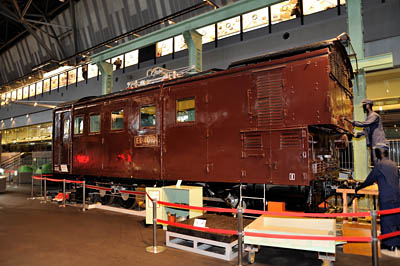
Electric Locomotive
Class ED40 |
First Japanese domestically mass-produced Rack Track system electric locomotive. |

|
On the first of April 1893, Shinetsu line connected Tokyo with Nagano and Niigata.
Shinetsu line finally opened to Usui pass between Yokokawa and Karuizawa with connecting tunnels on a rather steep slope.
There was a maximum of 6.67% per steep slope (66.7m per 1000m mount slope) on that section,
therefore, this section was laid on a Abt (Abet) System which was a kind of Rack Track System.
However, it required 1 hour and 15 minutes to cover a distance of only 11.2 kms by steam, additionally there were 26 tunnels on this short section, so choking often resulted as a consequence. As a result, main line electrification was planned for this section for the first time in Japan except for urban lines. The electrification was completed on the 11th of May 1912, and an electric train could now travel between Yokokawa and Karuizawa in 45 minutes. (The present Nagano Shinkansen needs only six minutes for passage on this section.) On this occasion, twelve Class 10000 (later the class name was changed to EC40) Abt type electric locomotives imported from the German builder AEG (Allgemeine Elektrizitats-Gesellschaft ). The electric mode was a DC 600V, with power collected from a pantograph at the station yard, but on the main line, operational power was collected on a third rail (electric-rail that was laid beside a rail), because the tunnel's height was not enough to hang overhead wiring.
At that time, Japanese private companies did not have the experience for the production of main line electric locomotives, so the government railway designed and produced an engine at the Omiya workshop. This was the first time that Japanese knowhow produced an electric locomotive via domestic production. Four electrics were manufactured during 1919, and were named Class 10020 No.10020-10023. Usui pass trains to Niigata were connected with one assisted engine in the front and two or three engines in the rear for up hill slope conditions. Returning trains from Niigata were connected with three or four assisted engines in the front. Afterward, a total of fourteen Class 10020 (No.10020-10033) were manufactured until 1923. Class 10020 was changed to Class ED40 No.1-14 from the class names revised during 1928. ED40s were active on Usui pass from Yokokawa depot until a new model ED42 appeared on the scene during 1940. During July 1943, No.3 and No.4 were transferred to the Nankai Tetsudo Co. During May 1948, No.9,11 and No.14 were transferred to the Sunzu Tetsudo Co. During January 1947, No.6 and No.10 were transferred to the Tobu Tetsudo Co. Other surviving JNR ED40s were retired and scrapped until March of 1952.
|
|
Preserved engine ED40 No.10 (1921 - 1968)
Transferred to the Tobu-Tetsudo Co's No.10 was named Tobu-ED4002 and later changed to ED602. And all of the Abt devices were disengaged when No.10 was transferred to Tobu-Tetsudo, and the trolley pole was installed on the roof so it could run on streetcar sections in Nikko city. ED602 was retired during 1968 on the Tobu-Tetsudo, and was endowed to the JNR for it's historical value. And it was remade to the original shape of the ED40_10 and was preserved at the JNR Omiya workshop. During October 2007, ED40_10 was moved to the new Railway Museum and exhibited.
|
Introduction |
Go to Top |